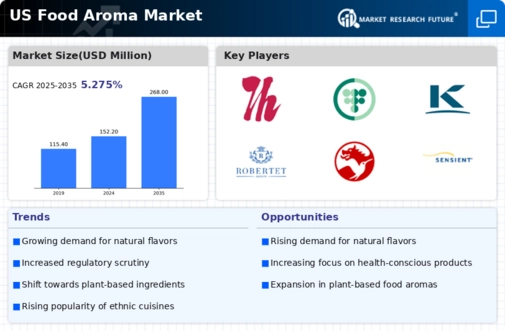The US Food Aroma Market is characterized by a dynamic landscape where various players compete to establish their offering and garner significant market share. This sector has increasingly captured consumer attention, leading to heightened demand for both natural and synthetic flavoring agents. The competition is driven by innovation in product development, rigorous quality standards, and a continuous focus on sustainability, as consumers are becoming more aware and concerned about the origins and compositions of the flavor agents they consume.
Moreover, the market is shaped by influential regulations and a growing trend towards healthier eating, necessitating companies to adapt and innovate in their product lines to stay relevant amidst fierce competition. Companies must leverage technology and consumer insights effectively to enhance their market positioning and respond to evolving consumer preferences.International Flavors and Fragrances stands out prominently in the US Food Aroma Market due to its robust portfolio of flavor solutions tailored to meet the diverse needs of food manufacturers and brands.
Renowned for its extensive experience and substantial investment in research and development, International Flavors and Fragrances has developed a reputation for producing high-quality flavors that enhance the sensory appeal of food products. The company boasts an advanced technological framework that aids in creating innovative flavors, thereby cementing its strong market presence. Its commitment to sustainability and responsible sourcing also resonates well with consumers seeking cleaner label products, further solidifying the company’s position in the market.
By focusing on consumer trends and maintaining a strong relationship with its clientele, International Flavors and Fragrances has successfully maintained its competitive edge in the US Food Aroma Market.T. Hasegawa has established itself as a notable player in the US Food Aroma Market with an impressive array of flavor solutions designed to meet the needs of various food and beverage applications. The company is recognized for delivering a combination of both traditional and innovative flavor products that cater to specific consumer tastes within the US. T.
Hasegawa’s strengths lie in its strong R&D capabilities and its emphasis on developing flavors that resonate with local consumer preferences, thereby ensuring market relevance. Furthermore, T. Hasegawa is engaged in strategic partnerships and acquisitions to enhance its product offerings and expand its footprint in the competitive landscape. Through these mergers and acquisitions, the company has been able to explore various segments and strengthen its market presence in the US. With a focus on product innovation and customer collaboration, T.
Hasegawa continues to fortify its position within the US Food Aroma Market, adapting to shifts in consumer demand while maintaining high-quality standards in its offerings.
















